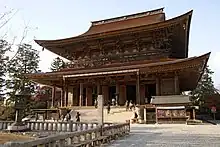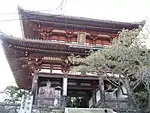Kimpusen-ji
Kinpusen-ji (金峯山寺, Kinpusen-ji) is the head temple of a branch of the Shugendō religion called Kinpusen-Shugendō in Yoshino district, Nara Prefecture, Japan. According to tradition, it was founded by En no Gyōja, who propagated a form of mountain asceticism drawing from Shinto and Buddhist beliefs. Along with Ōminesan-ji Temple, it is considered the most important temple in Shugendō.[1]
| Kinpusen-ji 金峯山寺 | |
|---|---|
 "Zaō-Hall" (Zaōdō), a National Treasure | |
| Religion | |
| Affiliation | Kinpusen-Shugendō |
| Deity | Zaō gongen (蔵王権現) |
| Location | |
| Location | 2498 Mount Yoshino, Yoshino, Yoshino district, Nara Prefecture |
| Country | Japan |
| Architecture | |
| Founder | En no Gyōja |
| Completed | Second half of 7th century |
| Website | |
| http://www.kinpusen.or.jp/ In Japanese | |
The temple's main building, the "Zaō-Hall" (Zaōdō) dedicated to Zaō gongen (蔵王権現), is the second largest wooden structure in Japan after the Great Buddha Hall at Tōdai-ji in Nara. Kinpusen-ji is a junction in a series of stops on pilgrimage routes.
A Shinto shrine dedicated to Inari Ōkami is attached to the main compound. In 1963, the Temple constructed a hall named Southern Court Mystic Law Hall (Nanchō Myōhōden) to appease the soul of the four emperors of the Southern Court and others who lost their lives in many battles since the "Northern and Southern Courts period" (Nanboku-chō period, 1336–1392). The principal image is the statue of Gautama Buddha (Shaka Nyōrai).
In 2004, it was designated as part of a UNESCO World Heritage Site under the name Sacred Sites and Pilgrimage Routes in the Kii Mountain Range.
Images
 Gate with guardians
Gate with guardians Statue of the wrath-filled and muscular guardian Nio
Statue of the wrath-filled and muscular guardian Nio Zaōdō (Deity: Zaō gongen, "Avatar Zaō")
Zaōdō (Deity: Zaō gongen, "Avatar Zaō") entrance of Zaōdō
entrance of Zaōdō one of the three Zaō-gongen statues in the Zaōdō
one of the three Zaō-gongen statues in the Zaōdō carvings
carvings Bell tower (Shorō)
Bell tower (Shorō) Aizendō (deity: Aizen myōō, Sanskr. Rāgarāja)
Aizendō (deity: Aizen myōō, Sanskr. Rāgarāja) Kannondō (deity: Kannon bosatsu, "Bodhisattva Guanyin")
Kannondō (deity: Kannon bosatsu, "Bodhisattva Guanyin") Itoku Tenmangu
Itoku Tenmangu Attached Inari shrine (Deity: Hisatomi Daimyōjin)
Attached Inari shrine (Deity: Hisatomi Daimyōjin) Inari shrine
Inari shrine Nanchō myōhō-den
Nanchō myōhō-den Statue of En no Gyōja near the Nanchō myōhō-den
Statue of En no Gyōja near the Nanchō myōhō-den
See also
References
- "About World Heritage Site Yoshino and Ōmine". Sacred Sites and Pilgrimage Routes in the Kii Mountain Range. Archived from the original on 2 February 2021. Retrieved 2 February 2021.